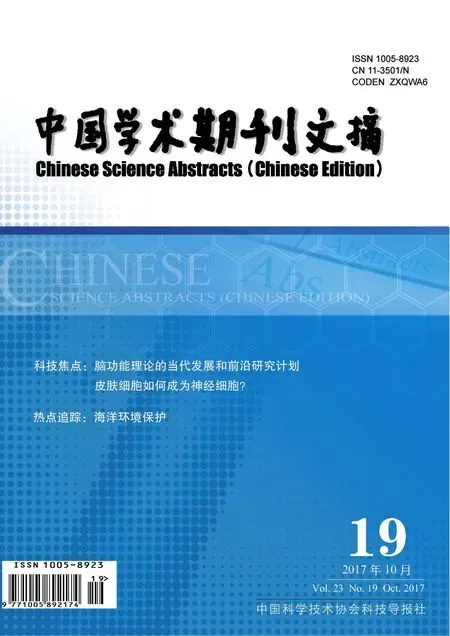海洋环境保护
Murphy, KR; Stedmon, CA; Waite, TD; et al.
Highly stable organic polymer field-effect transistor sensor for selective detection in the marine environment
Knopfmacher, O; Hammock, ML; Appleton, AL; et al.
Using unmanned aerial vehicles (UAV) for highresolution reconstruction of topography:The structure from motion approach on coastal environments
Mancini, F; Dubbini, M; Gattelli, M; et al.
Mapping the diatom redox-sensitive proteome provides insight into response to nitrogen stress in the marine environment
Rosenwasser, S; van Creveld, SG; Schatz, D; et al.
我国海洋环境污染的现状、成因与治理
王淼,胡本强,辛万光,戚丽
中国赤潮的发生趋势和研究进展
周名江,朱明远,张经
海洋环境保护
·编者按·
海洋是人类生存所不可缺少的物质和能量的源泉,也是许多废弃物的归宿。海洋环境(Marine Environment)是一个非常复杂的系统,包括海水、海洋中的各种物质、海底沉积物和海洋生物。随着人类活动的加剧,海洋资源开发的规模越来越大,海洋环境问题也日趋突显。
我国拥有超过1.8×104km的大陆海岸线,6500多个岛屿,管辖了超过3×106km2的海域。随着对海洋资源的不断开发,海洋生态及环境的保护也面临着日益严峻的挑战。海洋污染的来源一般为陆源污染、不合理的海洋开发和海洋工程兴建、海洋石油勘探开发污染、倾倒废物污染、船舶排放污染等。我国目前实施陆源污染物总量减排工程、开展海洋垃圾污染控制工程等方式控制海洋环境污染。同时在政策、法律、资金、产业、技术以及制度建设等方面采取相应的措施。
本专题得到曹西华研究员(中国科学院海洋研究所)、陈新军教授(上海海洋大学)、刘冬艳研究员(中国科学院烟台海岸带研究所)的大力支持。
·热点数据排行·
截至2017年9月12日,中国知网(CNKI)和Web of Science(WoS)的数据报告显示,以“海洋环境保护”等为词条可以检索到的期刊文献分别为7340与3278条,本专题将相关数据按照:研究机构发文数、作者发文数、期刊发文数、被引用频次进行排行,结果如下。

研究机构发文数量排名(CNKI)
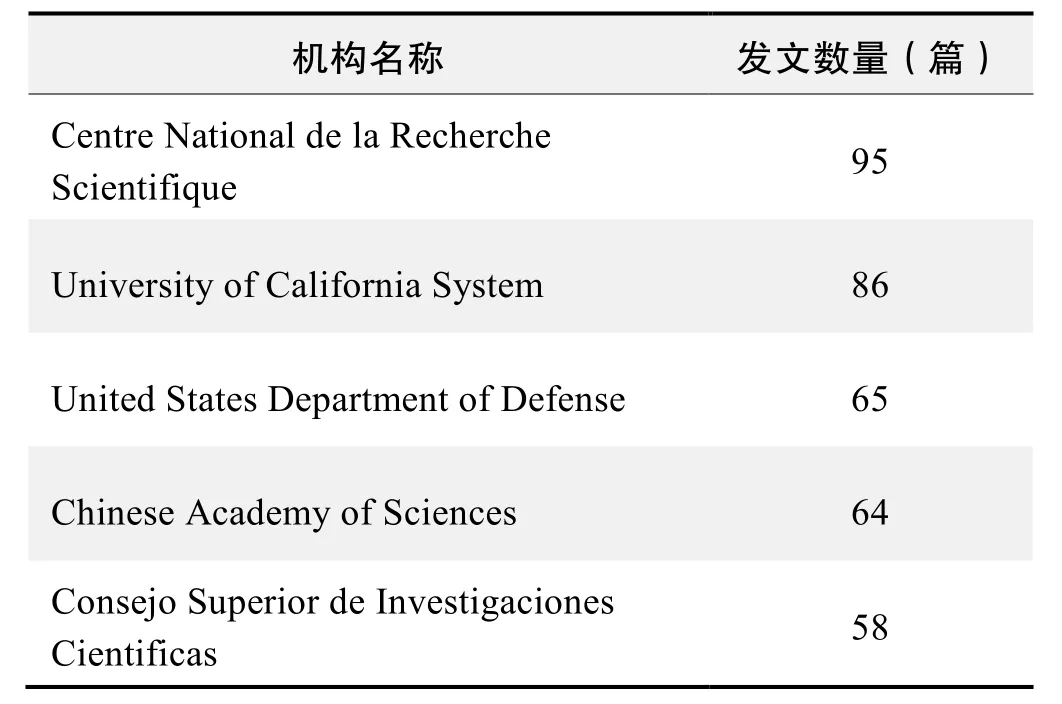
研究机构发文数量排名(WoS)
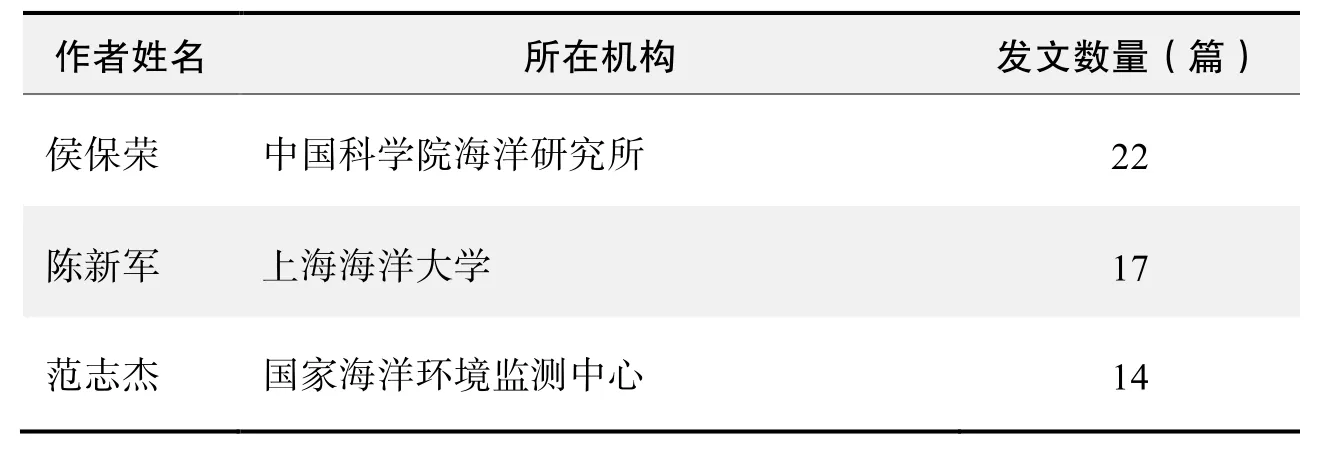
作者发文数量排名(CNKI)

作者发文数量排名(WoS)

作者发文数量排名(CNKI)(续表)
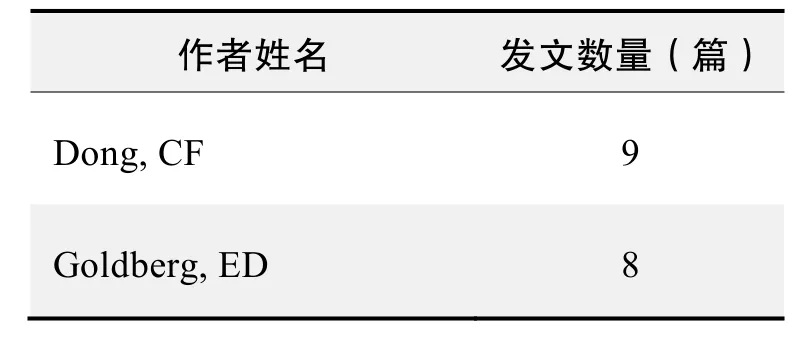
作者发文数量排名(WoS)(续表)
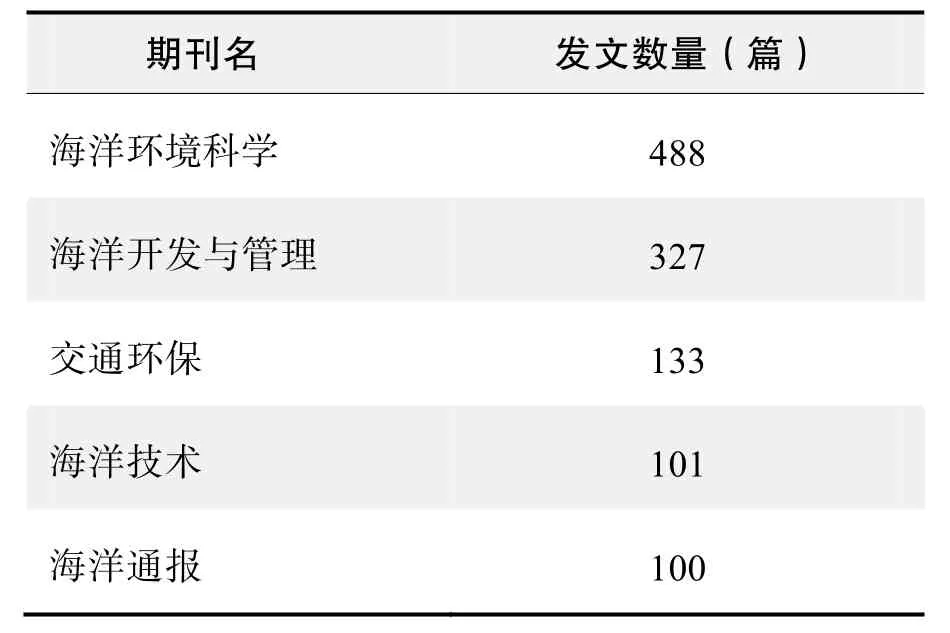
期刊发文数量排名(CNKI)

期刊发文数量排名(WoS)
根据中国知网(CNKI)数据报告,以“海洋环境保护”等为词条可以检索到的高被引论文排行结果如下。
根据Web of Science统计数据,以“海洋环境保护”等为词条可以检索到的高被引论文排行结果如下。
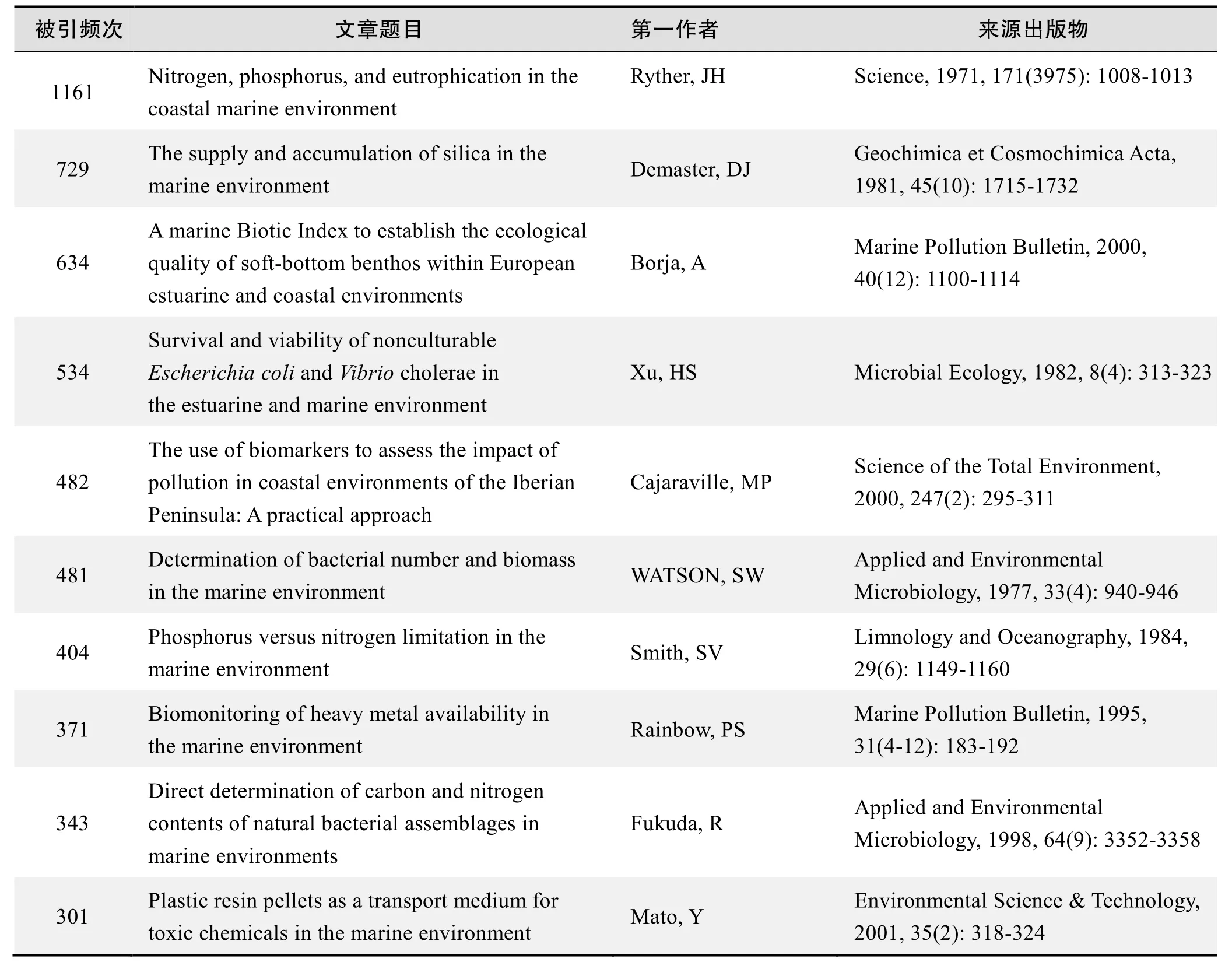
国外数据库高被引论文排行
·经典文献推荐·
基于Web of Science检索结果,利用Histcite软件选取LCS(Local Citation Score,本地引用次数)TOP 30文献作为节点进行分析,得到本领域推荐的经典文献如下。
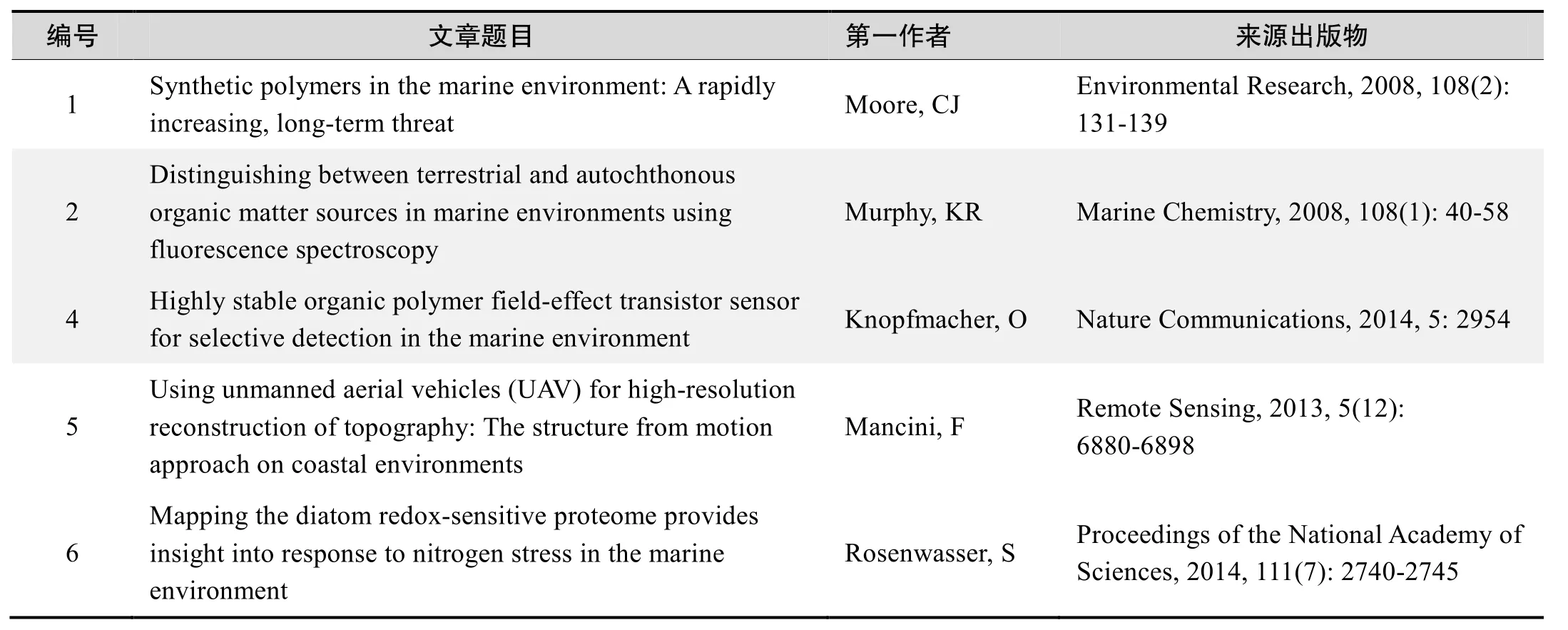
本领域经典文献
marine debris; plastic debris; thermoplastics;persistent organic pollutants; micro-plastic pollution;xenoestrogens
来源出版物:Environmental Research, 2008, 108(2):131-139
Distinguishing between terrestrial and autochthonous organic matter sources in marine environments using fluorescence spectroscopy
Murphy, KR; Stedmon, CA; Waite, TD; et al.
Abstract:The optical properties of chromophoric dissolved organic matter (CDOM) are frequently used as tracers of water masses in bays and estuaries but present unique challenges in the ocean due to the small quantities of organic matter present and the similarities between spectra from coastal and offshore environments. Samples collected on trans-oceanic cruises in the Pacific and Atlantic oceans were used to investigate the optical characteristics of dissolved organic matter in waters with limited freshwater influence (salinity > 30). Parallel Factor Analysis (PARAFAC) of fluorescence spectra revealed that coastal and oceanic dissolved organic matter (DOM)fluorescence could be separated into at least eight separate components: 4–5 humic-like and 3–5 protein-like signals.Two of the humic components were identified as representing terrestrial organic matter and their signals could be traced in the open ocean (Pacific and Atlantic) at levels of approximately 1.5% of riverine concentrations.An additional humic component, traditionally identified as the “marine” or “M” peak, was found to be both sourced from land and produced in the ocean. These results demonstrate that the supply, mixing and removal of terrestrial organic matter in oceanic waters can be observed with relatively simple measurement techniques,suggesting that fluorescence spectroscopy could play a useful role in future studies of the origin and fate of DOM in oceanic environments.
关键词:dissolved organic matter; tracer techniques;fluorescence spectroscopy; Parallel Factor Analysis(PARAFAC)
来源出版物:Marine Chemistry, 2008, 108(1): 40-58
Highly stable organic polymer field-effect transistor sensor for selective detection in the marine environment
Knopfmacher, O; Hammock, ML; Appleton, AL; et al.
Abstract:In recent decades, the susceptibility to degradation in both ambient and aqueous environments has prevented organic electronics from gaining rapid traction for sensing applications. Here we report an organic field-effect transistor sensor that overcomes this barrier using a solution-processable isoindigo-based polymer semiconductor. More importantly, these organic field-effect transistor sensors are stable in both freshwater and seawater environments over extended periods of time.The organic field-effect transistor sensors are further capable of selectively sensing heavy-metal ions in seawater. This discovery has potential for inexpensive,ink-jet printed, and large-scale environmental monitoring devices that can be deployed in areas once thought of as beyond the scope of organic materials.
来源出版物:Nature Communications, 2014, 5: 2954
Using unmanned aerial vehicles (UAV) for highresolution reconstruction of topography:The structure from motion approach on coastal environments
Mancini, F; Dubbini, M; Gattelli, M; et al.
Abstract:The availability of high-resolution Digital Surface Models of coastal environments is of increasing interest for scientists involved in the study of the coastal system processes. Among the range of terrestrial and aerial methods available to produce such a dataset, this study tests the utility of the Structure from Motion (SfM)approach to low-altitude aerial imageries collected by Unmanned Aerial Vehicle (UAV). The SfM image-based approach was selected whilst searching for a rapid,inexpensive, and highly automated method, able to produce 3D information from unstructured aerial images.In particular, it was used to generate a dense point cloud and successively a high-resolution Digital Surface Models(DSM) of a beach dune system in Marina di Ravenna(Italy). The quality of the elevation dataset produced by the UAV-SfM was initially evaluated by comparison with point cloud generated by a Terrestrial Laser Scanning(TLS) surveys. Such a comparison served to highlight an average difference in the vertical values of 0.05 m (RMS =0.19 m). However, although the points cloud comparison is the best approach to investigate the absolute or relative correspondence between UAV and TLS methods, the assessment of geomorphic features is usually based on multi-temporal surfaces analysis, where an interpolation process is required. DSMs were therefore generated from UAV and TLS points clouds and vertical absolute accuracies assessed by comparison with a Global Navigation Satellite System (GNSS) survey. The vertical comparison of UAV and TLS DSMs with respect to GNSS measurements pointed out an average distance at cm-level(RMS= 0.011 m). The successive point by point direct comparison between UAV and TLS elevations show a very small average distance, 0.015 m, withRMS= 0.220 m.Larger values are encountered in areas where sudden changes in topography are present. The UAV-based approach was demonstrated to be a straightforward one and accuracy of the vertical dataset was comparable with results obtained by TLS technology.
关键词:UAV; structure from motion; terrestrial laser scanning; digital surface model; beach dunes system
来源出版物:Remote Sensing, 2013, 5(12): 6880-6898
Mapping the diatom redox-sensitive proteome provides insight into response to nitrogen stress in the marine environment
Rosenwasser, S; van Creveld, SG; Schatz, D; et al.
Abstract:Diatoms are ubiquitous marine photosynthetic eukaryotes responsible for approximately 20% of global photosynthesis. Little is known about the redox-based mechanisms that mediate diatom sensing and acclimation to environmental stress. Here we used a quantitative mass spectrometry-based approach to elucidate the redoxsensitive signaling network (redoxome) mediating the response of diatoms to oxidative stress. We quantified the degree of oxidation of 3845 cysteines in thePhaeodactylum tricornutumproteome and identified approximately 300 redox-sensitive proteins. Intriguingly, we found redoxsensitive thiols in numerous enzymes composing the nitrogen assimilation pathway and the recently discovered diatom urea cycle. In agreement with this finding, the flux from nitrate into glutamine and glutamate, measured by the incorporation of15N, was strongly inhibited under oxidative stress conditions. Furthermore, by targeting the redox-sensitive GFP sensor to various subcellular localizations, we mapped organelle-specific oxidation patterns in response to variations in nitrogen quota and quality. We propose that redox regulation of nitrogen metabolism allows rapid metabolic plasticity to ensure cellular homeostasis, and thus is essential for the ecological success of diatoms in the marine ecosystem.
来源出版物:Proceedings of the National Academy of Sciences, 2014, 111(7): 2740-2745
·推荐综述·
我国海洋环境污染的现状、成因与治理
王淼,胡本强,辛万光,戚丽
1 我国近海环境污染现状及评价
1.1 全海域环境质量状况
1.1.1 我国海域海水环境质量
20世纪90年代以来,我国海洋环境污染一直比较严重。其中,我国近海水质劣于一类海水水质标准的面积,从1992年的10万km2,上升到1999年的最高值20.2万km2,平均每年以14.6%的速度增长。1999年以后,我国的海洋环保工作初显成效,总体污染状况得到改善,污染加重的势头得到遏制,全海域未达到清洁海域水质标准的面积由1999年的20.2万km2,逐年下降到2004年的16.9万km2,减少了16.3%,环境污染状况得到了初步的改善。但2004年的数据显示,全海域未达到清洁海域水质标准的面积约16.9万km2,比2003年增加约2.7万km2,我国近岸中度和严重污染海域范围增加。
对于渤海、黄海、东海、南海四海区的2001—2004年海水环境污染状况研究表明:在渤海、黄海、东海和南海四个海区中,渤海和东海海水污染程度较重。渤海未达到清洁海域水质标准的面积约2.4万km2,约占渤海总面积的1/3,受污染程度较为严重;黄海未达到清洁海域水质标准的面积中大部分为较清洁和轻度污染,受污染程度相对较低;东海主要污染区域相对集中且污染程度较重,主要集中在长江口和杭州湾海域,未达到清洁海域水质标准的面积中严重污染和中度污染比重相对较大;南海总体污染程度较低,未达到清洁海域水质标准的面积中大部分为较清洁和轻度污染,中度污染和严重污染海域主要集中在珠江口、汕头和湛江港近岸局部水域。
1.1.2 主要入海口海域污染状况
20世纪末以来,由于江河携带大量陆源污染物入海,我国近岸2/3的重点海域受到营养盐污染。其中,辽河口、大连湾、胶州湾、长江口、杭州湾、象山湾、三门湾、乐清湾、闽江口、珠江口等海域污染较重,且污染范围不断扩大,大部分河口、海湾以及大中城市邻近海域污染日趋严重。对我国主要入海口海域污染状况研究表明:入海口海域独特的地理位置决定着其直接承受沿海、沿江居民排放的城市生活污水、食品工业废水及残渣、人畜粪便、造纸工业废物等富含有机物质及其他污染物,是污染物最为集中,密度最高的区域。在我国受污染海域中,主要入海口海域污染程度相对严重,主要污染物质是无机氮、磷酸盐、油类以及有机物和重金属。
1.1.3 海洋生物质量状况
海洋生物是海水环境和沉积环境污染的直接受害对象,并且海洋环境中的污染物对海洋生物质量的影响具有累积作用,其体内的污染物含量反映了其生存环境的质量,可食用底栖生物质量的好坏对人体健康更是有着直接的影响。目前,我国海洋生物质量状况并不乐观,主要表现为:海洋生物结构失衡,珍稀濒危物种减少;主要经济生物体内有害物质残留量偏高;沿岸经济贝类卫生状况欠佳。
1.1.4 近海沉积物环境质量现状
从1999到2004年海洋沉积物质量监测结果表明,我国近海和远海海域的海洋沉积物质量总体上保持良好,沉积物污染的综合潜在生态风险较低,但部分近岸海域沉积物受到污染比较严重,尤其是一些河口、海湾的沉积物污染较重。在我国近岸、近海和远海海域中,海洋沉积物主要污染物为汞、铜、镉、铅、砷、滴滴涕、多氯联苯、石油类、硫化物、有机质等。其中,大连湾、锦州湾和珠江口海域沉积物五年来污染持续加重。部分区域贝类体内残留的铅、镉、砷、六六六、滴滴涕及粪大肠菌群等有毒物质含量数年居高不下。
1.1.5 海洋生态环境状况
我国四大海区具有很多高生产力的海洋生态系统,如沿岸浅海生态系统、河口生态系统、近岸上升流生态系统、海藻(草)场生态系统、红树林生态系统、珊瑚礁生态系统、大洋生态系统等,其中蕴藏着各类丰富的海洋资源,成为我国沿海地带经济与社会发展的重要基础。
根据对渤海、黄海、东海、南海的调查分析,从总体上看,主要海湾、河口及滨海湿地生态系统处于亚健康或不健康状态。海洋生态环境恶化主要表现在:沿岸和近海海域多数传统优质渔业资源日趋枯竭,导致海洋生物资源严重衰退,一些珍稀物种处于濒危状态;富营养化及营养盐失衡,生物群落结构异常;河口产卵场严重退化,部分产卵场正在逐步消失,生境丧失或改变等。除了远海海域因离岸较远而环境良好以外,沿岸和近海海域已有相当部分受到一定程度的污染,环境质量普遍下降。在一些重要河口、港湾水域,生态环境也严重恶化,生物多样性大为降低,赤潮频发;许多典型生态系统面积急剧缩小,自然景观不断破坏。港口淤积、航道萎缩、海岸侵蚀以及风暴潮和台风灾害等问题也因生态环境恶化而日趋严重。
我国的一些典型海洋生态系统遭到破坏。20世纪50年代,全国红树林面积约5.5万公顷,到2002年,红树林面积已不足1.5万公顷,减少了73%,广东、海南和广西红树林分布面积分别减少82%、52%和43%。石油开发和围填海等人为活动导致我国滨海湿地丧失严重。据初步估算,我国累计丧失滨海湿地面积约219万公顷,占滨海湿地总面积的50%。此外,由于大量开采珊瑚礁,近岸海域珊瑚礁生态系统受到严重破坏,珊瑚礁分布面积已经减少80%。作为浅海水域初级生产力最高的生物栖息地之一的海草床已经消失。
1.2 我国海洋环境质量评价
2004年,近岸海域污染依旧严重,严重污染海域主要分布在鸭绿江口、辽东湾、渤海湾、长江口、杭州湾、珠江口等局部水域。
全海域未达到清洁海域水质标准的面积约16.9万km2,比2003年增加了2.7万km2。从总体上来看,我国海域的污染状况仍未得到缓解,特别是中度污染增加15900 km2,增幅达106.6%;严重污染海域面积增加7380 km2,增幅达29.9%,污染程度明显增强。
我国海域未来几年污染仍将以营养盐为主要污染物,受污染的海域面积在短期内不会有明显减小,在某些海域污染状况仍将持续处于严重状态,赤潮的发生次数和影响面积在短期内不会得到有效控制,赤潮仍将是主要的海洋灾害。海洋生态所承受的负重仍然非常沉重,需要加大对海洋环境治理的力度,以实现我国海洋经济的持续发展。
2 我国海洋环境污染的成因
2.1 海洋污染源的形成
2.1.1 陆源污染
海洋污染物总量的85%以上来自于陆源污染物,其成分主要是化学需氧物质、氨氮、油类物质和磷酸盐四类,合计占总量的95%以上,还有硫化物、锌、砷、铅、铬、挥发酚、氰化物、铜、镉、汞等。陆源污染物主要来自于工业三废、城镇生活垃圾、农业养殖使用的化肥、农药和禽畜粪便等。因此,陆地污染源可分为4类:工业污染源、生活污染源、农业污染源和陆上养殖污染源。
2.1.2 不合理的海洋开发和海洋工程兴建
我国曾在20世纪50年代和80年代分别掀起了围海造田和发展养虾业两次大规模围海建设热潮,使沿海自然滩涂湿地总面积缩减了约一半。其后果是滩涂湿地的自然景观遭到了严重破坏,重要经济鱼、虾、蟹、贝类生息繁衍场所消失,许多珍稀濒危野生动植物绝迹,而且大大降低了滩涂湿地调节气候、储水分洪、抵御风暴潮及护岸保田等能力。据不完全统计,我国沿海地区累计已丧失滨海滩涂湿地面积约119万公顷,另因城乡工矿占用湿地约100万公顷,两项之和相当于沿海湿地总面积的50%。对沿海滩涂的破坏面积仍呈逐年上升趋势。海岸工程破坏自然滩涂,我国沿岸大于10 km2的海湾有160个。许多海湾已建有大、中型港口,小型海湾普遍为天然渔港。但是,在大城市毗邻的海湾,由于填海建港、填海造地,岸线缩短、湾体缩小、人工海岸比例增高、浅滩消失,海岸自然程度降低。再加上海水养殖业的盲目发展,养殖自身污染也较为普遍,海湾潮间带和水域中天然生长的鱼、虾、蟹、贝、藻普遍衰退。不合理的海洋开发和海洋工程兴建可分为四类:海水养殖、围海造地、海岸工程、深海开发。
2.1.3 海洋石油勘探开发污染
海洋石油勘探开发造成的海洋污染主要产生于两个方面:一是正常作业污染,即海洋油田的勘探和生产过程中造成的污染;二是突发性污染,即海域油井意外泄漏。
2.1.4 倾倒废物污染
近几年,随着经济建设的进一步推进以及城镇化建设步伐的加快,我国加大了对海洋倾倒区的使用力度,其中倾倒的废物主要是疏浚物、渣土等。进入21世纪,我国海洋倾倒区的个数由2001年的61个增加到了2004年的80个,签发的倾倒许可证数由2001年的541份增加到2004年的602份,倾倒的废物量从2001年的8965.2万m3增加到2004年的14661万m3。国家海洋局对部分海洋倾倒区进行了全面监测。监测结果显示:与倾倒区选划时的环境质量状况比较,个别海洋倾倒区的环境状况发生显著的变化,部分倾倒区及周边底栖环境的总生物量略有减少,底质环境状况局部倾倒区恶化,但尚有底栖生物存在,其优势类群主要为软体动物和节肢动物,部分倾倒区的水深略有减少。
2.1.5 船舶排放污染
船舶对海洋的污染主要指船舶在航行、停泊、装卸过程中产生的污染。相关资料统计表明,海洋环境污染中有35%的污染物来自于船舶。特别是海洋中石油类污染物,其中陆上工业排放和城市排放占37%,而船舶操作性排放则占33%。船舶排放物已经成为造成海洋环境污染,扰乱海洋生态平衡系统的主要污染源之一。船舶海洋污染主要包括民用船舶污染和军用船舶污染。民用船舶污染主要是操作性污染,即船舶有意识地将船舶产生的污染物质排放入海,军用船舶除了能产生民用船舶的污染之外,其核动力船舶还能产生放射性辐射污染。
2.1.6 海上事故污染
海上事故污染是指运载有毒有害物质的船舶在航行中因过失或不可抗力而造成的有毒有害物质泄漏所形成的污染。由于不可抗力致使船舶触礁、碰撞、搁浅、爆炸等事故,使有害物质进入海洋,对局部海域造成重大污染。这类事故多发生于近岸海域,对海洋环境造成的危害特别大,主要有溢油污染、化学危险品污染、液化气船重大事故污染等。
2.1.7 湿地人为破坏
我国大约有湿地2500多万公顷,其中包括1100万公顷沼泽,1200万公顷湖泊以及210万公顷的滩涂、盐沼地,约占国土面积的2.6%,占全世界湿地总面积的13%左右。还有以潜育化和沼泽化水稻田为主的人工湿地,加上水库池塘等,总面积约50万公顷。对湿地的开发,致使海滨生态环境恶化。沿海滩涂湿地在我国所有的湿地类型中遭受的破坏最为严重。到20世纪80年代末,我国围垦的海岸滩涂湿地达119万公顷,其中81%改造为农田,19%用于盐业生产,再加上城乡工矿用地100万公顷,占到了沿海湿地总面积的一半。湿地的人为破坏主要表现在农业开垦、城镇化开发、矿产开发等方面。
2.2 海洋污染的深层次原因
2.2.1 人口和资源对海洋的压力
人类社会的发展,人民生活水平的大幅度提高,人口的急剧增加,使资源的供求量相应增加。陆地资源的稀缺性,使人类不得不到海洋去获取资源。解决人口、环境和资源三大问题,主要依靠海洋。
2.2.2 社会公众海洋环保意识的淡薄
社会公众对海洋环境的保护意识是极其薄弱的。用生活垃圾填海、农业用药的不合理处置等使许多鱼类、贝类产卵场、栖息地被破坏。由于社会公众的海洋环保意识淡薄,使海洋遭到严重损害。资料表明,受陆源排污影响,约80%的入海排污口邻近海域环境污染严重。
2.2.3 社会经济发展的影响
随着我国市场经济建设的不断推进,海洋经济得到了发展,但对海洋环境的污染也随着沿海经济的增长而上升,对海洋环境产生了极大的负面影响。主要表现在企业对海洋环境造成的污染、近岸养殖业对海洋环境的污染、船舶对海洋环境的污染、来自海洋石油勘探的污染、海洋开发活动决策失误所造成的污染、港口建设对海洋自然生态环境的污染等方面。
2.2.4 现代海洋科技的应用
海洋污染除了由于大量工业三废、生活垃圾、农药、石油等所导致外,还有海洋放射性污染。海洋放射性污染通过生物体富集或食物链富集辐射整个海洋环境,危害人类或其他生物。现代高技术的发展和应用已经深入到现代海战武器(如激光炮、电磁炮、微波武器等)之中。此外,目前一些国家建立了海底核基地,其海底核实验活动直接或间接对我国海洋环境产生的危害也是相当严重的。
2.2.5 海洋监察手段落后和执行力不足
国家海洋局每年承担常规海洋环境监测,以及两次污染基线调查、陆源污染及重点排污调查、几个海湾的海洋环境容量与总量控制调查,以对近岸海域污染物排放总量进行控制。目前,海洋环境容量的大小和污染源的对应关系仍不清楚,还不能有针对性地控制污染物质的排放,从而最大限度地减少污染。另外,在监测的空间和时间覆盖范围方面体现出执行力不足的问题,海洋环保法实施18年,累计达6000多天,300万km2的海域,海洋部门两天才出动一次船舶,4天才派出一架飞机,且飞行不足5 h,其发现某一船只违章排污的概率相当小。
2.2.6 涉海行政部门协调不够
根据现行法规,海洋环境保护的管理工作由国家海洋局、国家环保总局、交通部、农业部、海事等部门以及沿海地方人民政府组织实施。各部门根据分工对不同类型的污染源实施监督治理。尽管法律明确规定了涉海各部门的职权范围,但各部门职能交叉、机构重复设置的问题依然存在。而且海洋部门不上岸,环保部门不下海,机构间和部门间缺少协作。环保、海洋、海事、渔政、军队环保部门共同参与海洋污染治理,互相扯皮的现象随之产生,影响了海洋环境污染的治理效果。
3 我国海洋环境污染治理的海域区划
为了加强海洋环境恶化海区的综合治理,科学确定不同海域环境的保护与治理主攻方向,根据纬度、温度带、生物多样性及海洋环境特点以及滩涂、河口港湾及浅海的生境特点,将我国海域划分为渤海、黄海、东海、南海和台湾海峡5个海域进行环境保护和污染治理。
3.1 渤海——特别保护区
3.1.1 海域特点
渤海是一个半封闭性的内海,受外海水影响小,受大陆影响大,入海河流较多,盐度较低,营养盐丰富,初级生产力较高,生物资源比较丰富。从区域环境系统上看,渤海由三个城市环境系统、三个海湾环境系统和三个流域环境系统构成。从海洋系统来说,渤海是黄海大海洋环境系的一个重要组成部分;从海岸系统来看,渤海与沿岸地区构成了独具北方区域环境特征的海岸带系统;渤海是海洋经济生物重要的产卵场、育幼场、洄游区,又是石油、海盐、景观、港口资源综合开发利用区,不仅在资源基础上对我国北部地区具有重要作用,也对我国的政治、军事、国家安全等具有战略影响。渤海仅占我国管辖海域面积的2.5%,但每年接纳污水30亿t、污染物70万t,占全国排入海域污水总量的32.2%、污染物总量的47.7%。由于其特殊的地理特征,水交换条件差,加上河流淡水入海量降低,海洋环境污染与环境结构破坏十分严重。传统渔业资源鱼类真鲷和带鱼基本消失,鳕鱼、小黄鱼和大黄鱼等主要经济鱼类形不成渔汛,渔获物中传统优质鱼类的比例只占20%左右。近年来赤潮频频发生,而且面积越来越广,危害越来越大。
3.1.2 海区定位及海域环境保护与治理方向
根据渤海的自然特性和功能特性,将渤海建设成为具有示范意义的环境和开发利用相适应的特别保护区。渤海海域的海洋环境保护和建设将结合“渤海综合整治计划”和“碧海行动计划”进行,其主攻方向是:实施全海域环境的综合整治,严格控制陆源污染物排放,加强海洋环境的监测与管理,进行重点海域的污染环境恢复工程,保护和修复湿地和岛屿重要环境功能区,补充和恢复海域的生物资源。
3.2 黄海——大海洋环境系
3.2.1 海域特点
黄海包括渤海海峡以南,长江口至济州岛连线以北海域,浅海海域宽阔平缓是黄海海域的重要特点。黄海沿海大部分岸段为泥沙质滩涂,浅海底质也以泥沙为主。滩涂及浅海坡度平缓、面积大,适合发展海水养殖,是我国海水养殖比较集中的海区。从总体上看,黄海海洋环境系统处于严重失调状态,其结构已经发生了显著变化,承载功能显著下降。近几年来,由于浅滩贝类掠夺式采捕,盲目建池养殖、围海造地,加上过度捕捞以及河口、港湾水质污染严重等原因,海洋环境受到严重破坏,赤潮灾害时有发生。沿岸河口、海湾生物多样性严重下降,传统的优质鱼类资源严重衰退,鳕鱼等多种主要传统经济鱼类已形不成渔汛。
3.2.2 海区定位及海域环境保护与治理方向
根据黄海的自然特性和功能特性,黄海与渤海共同构成黄海大海洋环境系。黄海的海洋环境保护与建设将结合联合国开发规划署的“黄海大海洋环境系”项目展开,其主攻方向是:严禁酷渔滥捕,实现捕捞量零增长,以养补渔,营建湿地和岛屿高产环境系统,恢复和养护海区的生物资源,重点建设滩涂环境系统,放养增殖贝类、藻类、虾类;在辽南沿海、山东半岛以及苏北沿岸,加紧建设“耕海牧渔”环境示范区。
3.3 东海——岛屿高生产力区
3.3.1 海域特点
东海海域包括长江口以南、福建海岸以北的海域,重点是长江口、杭州湾、舟山群岛和南麂列岛海域。由于长江等径流和沿岸上升流带来丰富营养物质,该海域生物多样性高,生物资源丰富,是世界四大渔场之一的舟山渔场所在地。由于海区渔业资源捕捞过度,海洋生物群落结构受到破坏,处于食物链高级层次的优质鱼类严重减少,次级层次的低质鱼类占优势。同时,工业污染及不合理的岸滩开发,又使处于食物链基础环节的近海浮游生物和贝藻类数量骤降,导致环境失衡,水质富营养化,赤潮频发,优质鱼类减产80%以上。东海沿岸经济发达,社会对海产品的需求量大,使本已脆弱的海洋环境压力增大。
3.3.2 海区定位及海域环境保护与治理方向
根据东海的自然特性和功能特性,将东海建设成以岛屿海产品养殖开发为主的岛屿高生产力区。东海海区海洋环境保护与治理的主攻方向是:以岛屿及小范围沿岸为单元,大力培植和保护原有的贝、藻类群落,营造岛屿高产环境系统,带动周围海区环境平衡的恢复。
3.4 南海——珊瑚礁和红树林环境功能保护区
3.4.1 海域特点
南海海域地处热带、亚热带,海洋生物多样性高,资源丰富,沿岸滩涂和近海分布着南部海域特有的珊瑚礁和红树林。海区渔业资源开发处于中等水平,自然环境系统保存较为完整。但由于长期盲目的砍伐采礁和严重水质污染等原因,沿岸自然护岸防灾功能基本丧失,依赖红树林、珊瑚礁的海岸高产环境系统受到灾难性破坏。年径流量仅次于长江口的珠江口海域已严重污染,赤潮频发,连续出现鱼类大量死亡事件。海域内的万山渔场等渔区已形不成渔汛。
3.4.2 海区定位及海域环境保护与治理方向
根据南海的自然特性和功能特性,将南海建设成珊瑚礁和红树林环境功能保护区。南海海区海洋环境保护与治理的主攻方向是:大力开展栽培红树林和移植保护珊瑚礁的建设,进一步建设滩涂红树林和远海珊瑚礁环境功能保护区,促进浅海水域生物资源的恢复;严格控制酷渔滥捕,加快优质鱼类的放流,强化育幼场保护,增加人工渔礁的投放量;实施珠江等河口的环境综合整治,以保护和恢复南海的生物多样性及其生物资源。
3.5 台湾海峡——过渡环境保护示范区
3.5.1 海域特点
台湾海峡属于东海与南海交汇海域,北界为福建省北茭至台湾省富贵岛,南界为广东省南澳岛至台湾省鹅銮鼻,是珊瑚礁和红树林环境系自然分布的北界,北回归线横穿台湾海峡,具有典型的亚热带特征。受东海和南海沿岸流以及黑潮的交叉影响,台湾海峡水文状况复杂,其特殊的地理位置造就了生物多样性高丰度区,整个海峡有闽东、闽中和闽南3大渔场。由于海洋开发活动加剧,海洋环境恶化,环境系统功能退化。滩涂、近岸水域超容量地过度性开发利用,致使鱼、虾、贝、藻病害不断。河口港湾富营养化现象严重,养殖鱼类死亡时有发生,海峡局部水域遭受外来物种入侵。
3.5.2 海区定位及海域环境保护与治理方向
根据台湾海峡的自然特性和功能特性,将台湾海峡建设成过渡环境保护示范区。台湾海峡海区海洋环境保护与治理的主攻方向是:预防与控制主要河口与港湾的环境污染,实施台湾海峡过渡区典型环境系统的保护与建设,有效扼制外来物种危害,建立海洋环境保护与建设示范区和国家珍稀濒危海洋生物种质基因基地。
4 我国海洋环境污染治理的实施对策
4.1 建立健全海洋法律体系与管理体制
自1978年以来,我国先后制定了《中华人民共和国领海及毗连区法》《中华人民共和国专属经济区和大陆架法》《中华人民共和国海洋环境保护法》《中华人民共和国渔业法》等一系列海洋和涉海法规,国务院及国家有关部门也制定了一系列行政法规和部门规章。这些涉海法律法规的颁布和实施,对促进我国海洋管理和海洋资源和环境保护起到了重要的作用。与此同时,我国逐步建立了海洋综合管理制度,编制了《全国海洋功能区划》《全国海洋开发规划》,发布了《中国海洋事业的发展白皮书》,制定了《全国海洋环境保护管理工作纲要》等。沿海各地市也先后建立和完善了海洋管理机构,并结合当地的实际制定了一些实施细则。这些措施为强化海洋管理,推动海洋资源和环境的可持续利用提供了依据和保证。
随着我国海洋开发利用的不断发展,必然会出现一些原有法律法规未曾涉及的问题,这就需要我国的法制工作者和管理者根据实际情况及时出台相关法律法规,始终使我国的海洋环境保护工作“有法可依”“有章可循”。法规是行为的依据,组织落实是执行法规的保证。根据现行法规,海洋环境保护的管理工作由国家海洋局、国家环保总局、交通部、农业部、海军等5个部门以及沿海地方人民政府组织实施。各部门根据分工对不同类型的污染源实施监督管理。例如,海洋部门主管防止海洋工程、海上倾废等活动造成污染损害方面的环境保护;环保部门主管陆源污染、海岸工程、拆船等活动造成污染损害方面的环境保护。各个部门间的分工表面上看是独立的,但实际上却存在着一定程度的交叉和重叠。执法部门应在加强自身建设的同时,加强部门间的横向联系,做到“协防、协查、协管”,努力把法制工作落到实处,始终做到“执法必严”,保证实现“有法必依,违法必究”。
4.2 不断提高海洋环境监测水平
高新技术在开发海洋环境探测新仪器方面的应用主要反映在两个方面,即水生探测技术和卫星遥感遥测技术。声学多普勒海流剖面仪(ADCP)的出现是水生探测技术的最新发展。探测方式有船载式、拖曳式、坐底式、自容式、直读式等多种形式,自动化程度很高,不仅可以测量一个垂直剖面上的海流分布,而且测量准确,使用方便,在现代海洋环境探测中得到广泛应用。卫星遥感可获得海洋表层的温度、水色、海平面、波浪、海流等相关信息,广泛应用于海洋环境监测和科学研究。应用卫星定位技术还进一步发展了现场观测技术系统。此外,其他新技术的应用,也推进了海上现场探测技术的发展。运用现代化的监测手段和技术,对海洋环境进行监管,及时发现违规行为,保护海洋环境,监测赤潮等是非常重要的。
4.3 实现海洋产业结构的高级化
优化海洋产业结构包括两个方面:一是优化海洋产业结构。不同的海洋产业结构对海洋资源的依赖程度和对环境的影响程度不同。从海洋第一产业、第二产业到第三产业对海洋资源的依赖程度和对环境的影响程度逐渐减弱。我国多年来的海洋产业结构一直是以海洋第一产业为主,今后应提高第二、三产业的比重,在实现海洋资源环境可持续利用的过程中,使我国海洋产业结构不断的优化和升级。二是优化沿海地区的产业结构。沿海地区所产生的“三废”绝大部分通过直接入海,河水和地表径流、酸雨等形式流入近海,影响着近岸海域的环境,近岸海域的环境状况和沿海地区经济结构,特别是产业结构的变化有着高度的相关性。从“三废”排放的一般情况来看,工业废水、废气占全部污染物的50%左右,所以第二产业对环境压力最大。而沿海地区是我国目前工业化程度较高的地区,第二产业在三个产业中所占的比重最大,这种产业结构严重地影响着近岸海域环境,应进一步加以调整,使之不断地优化和升级。要搞好沿海工业布局,积极引导和发展起点高、能耗少、技术含量高和经济效益好的工业产业;对能耗大、污染重、经济效益差的工业产业要严格限制或取缔。沿海地区要充分利用海洋优势进行合理的工业产业布局,严禁把海洋当作垃圾池,以牺牲海洋环境为代价的现象发生。
4.4 推动海洋环保技术产业化的进程
海洋环保技术是指为防止或减少海洋环境污染,保证海洋生态平衡的各项技术。它包括海洋环境监测预警信息技术,如检测设备、资料浮标、无人值守站、卫星遥感等;污染物控制技术,如废弃物处理技术、溢油事故处理技术、倾废技术等;环境无害化技术或清洁生产技术,如资源综合利用技术、以预防污染为目标的少废或无废的工艺技术和产品技术;海洋生态恢复和整治技术等等。海洋环保产业,是在海洋环保技术基础上发展起来的一类经济产业,包括海洋监测预警信息服务业、海洋环保设备制造业、污水处理厂、垃圾处理厂、海上倾废场等海洋污染物处理企业以及为预防海洋环境污染而进行的资源再生利用等产业部门和单位。在我国的海洋环境治理过程中,积极运用环保技术,培育相关产业能获得事半功倍的效果。
4.5 加强海洋污染治理试验区、环境保护区的 建设与管理
建立污染治理试验区的目的在于加强对重点污染海区的整治与管理,并对今后的污染治理有一定的示范作用。由于海洋污染复合性强,累积效应大,而且不同海域的自净能力不同,因此,必须考虑如何以最少的资金投入获得最大的污染治理效果。海洋污染治理试验区就是在我国目前缺乏环保资金投入的前提下,抓住主要污染物质、主要污染海域、主要污染源等几个主要环节,充分利用海洋自净能力,对我国的海洋治理进行尝试,是当前治理海洋污染的一个关键环节。可以选择一个或几个生态环境遭受破坏、环境污染较轻的小块海域进行试点,建立试验区的管理机构,设立环境监测系统,制定海域有偿使用制度,研发污染物的转移与防治技术,并逐渐加以推广。对于重点污染海域的整治与管理,则应与当地政府配合,建立“当地政府负责制”,并且纳入当地经济规划。以当地的经济发展为基础,实行“谁开发,谁保护”“谁污染,谁补偿”,制定一系列排污收费制度。在国家的资助下,分阶段、有计划地整治污染海域。在加强海洋污染治理试验区的同时,还要加强对现有自然保护区的管理。首先,要完善机构,增添设备,实行核心区全封闭保护,进行系列生态研究,把所有已选划的保护区尽早地建立起来。要防止各种人为侵袭,使自然生态质量不下降,保护对象基本安全。其次,对少数不合格的保护区,要采取降级或限期整顿;对遭受严重破坏,已失去保护价值的保护区要予以撤销;对可以合并的相邻保护区要加以合并,以便有效管理。更重要的是,要在加强管理的基础上,开展必要的科学研究。定期对现有的自然保护区分期、分批地进行调查,摸清区内的生物种类和生态结构,包括群落组成、分布特征以及非生物环境要素的状况,并建立数据库,以利于以后比照。有条件的保护区要建立生态试验室,开展系列试验生态研究和专题调查研究。积累保护区资料,以逐步进入规范化的科学管理轨道。要积极稳步的增建一批国家级及地方级保护区,以初步形成我国海洋自然保护区体系。
4.6 坚持陆海并重、防治并举的海洋环保方针
海洋污染表现在海上,但其来源于陆地和海上,其中主要是陆地。因此,改善海洋环境质量,必须坚持陆海并重。第一,要有效实行排海污染物浓度控制和总量控制的双重控制制度。由于对污染物的排放单纯的以“浓度标准”为基础,不能控制陆源污染物的排海总量,难以起到保护环境的作用,所以应实行排海污染物浓度控制和总量控制的双重控制制度。根据海洋区域自净能力建立污染物排放总量控制目标及区域分目标体系,建立成分及浓度控制体系。控制排放入海的污染物的种类、数量和速度。加强对企业和市政向海洋排污的监督和控制,做到达标排放,违法者依法追究。第二,要积极推行绿色生态模式,合理发展农业和养殖业。站在社会、经济和生态和谐发展的战略高度,制定适合农业、养殖业可持续发展的发展计划,并分解为阶段性的、可操作的具体实施方案,强化农业、养殖业的生态发展。根据生物链规则,综合利用农业、养殖业中的各种资源;根据科学的方法,合理的确定发展规模,科学使用农药、化肥、饲料等,减少农业和养殖业对海洋的污染。同时,要大力发展节水农业,提高水资源的使用率。第三,市政部门要做好节约用水和处理污水工作。在企业中要积极推行清洁生产,提高水的循环使用。加强城镇的污水处理,合理确定污水处理设施的布局和规模,力争所有的污水都在得到有效处理后排海。第四,加强地区间的污染处理协调工作。对通过河流排污者,要进行跨地区、全流域的监管和治理,地区之间要联合起来防污、治污。各地区要对自己所辖范围的防污治污工作负责,保证污水在处理达标以后向河流排放,不能把污染转移给河流的下游。第五,抓好海上污染控制,保护好近海生态环境。加强对钻井平台、船舶的管理,解决好污染水和生活垃圾的接收问题;严格海上倾废管理,合理选择倾废区;合理布局海水养殖业,科学确定海水养殖量;大力建设海洋保护区,强化海岸的保护和防护林建设,严禁开采珊瑚礁、采伐红树林和防护林,逐步改善沿海生态环境。
4.7 保证海洋环境保护与污染治理的资金投入
由于投资见效慢,各方面关系难以协调,而且没有短期的经济效益,所以海洋生态环境的保护和建设,必须由国家和地方政府承担资金投入的主体,同时要加强引导,积极利用国际资金和民间资金。
短时间内减少污染物的入海量是不现实的,应该投入资金建设污染处理设施,建立生态污染处理系统。根据各城镇社会经济发展的规模和增长趋势,科学地确定污水处理厂的布局和规模。国家应大力支持人工湿地处理系统的建设,如芦苇、红树林湿地生态系统,由于其对营养富集和富营养化具有良好的耐受性,且大多处于营养贫乏状态,能过滤和吸收污水中的营养物质,并能转化为植被的生物量。对这样的污水生态系统,政府应当给予资金支持或给予财政利息补贴,还应引入国际资本或民间资本迅速促进湿地生态的恢复和发展。对于处理后的污水,国家和地方政府应投入资金,研究各海域的物理自净、化学自净和生物自净能力,确定其净化能力的有效时间和空间,能容纳不同成分污染物的容量,从而选择合适的入海方式和入海地点,控制不同成分污染物的入海量。
4.8 营造海洋环境保护的社会氛围
目前,我国海洋开发总体水平仍然不高,海洋环境污染日益严重,赤潮等海洋灾害造成的损失逐年增加,因此,要提高全民的海洋环境保护意识,充分认识治理海洋污染,保护海洋生态环境的重要性和紧迫性。
海洋生态环境保护与建设是一项长期而艰巨的任务,必须长抓不懈。要充分利用科研院校的教育优势。普及海洋生态环境知识、海洋经济和生态可持续发展知识,最重要的是向社会培养和输送高水平的海洋专业技术人才,将海洋生态环境保护的理论知识应用到海洋经济建设中去。要广泛深入地进行海洋环境保护方面的宣传教育,进一步增强全民特别是各级领导干部的海洋环保意识。通过各种形式的宣传教育,让群众意识到保护海洋生态环境是当今人类的共同责任;让领导干部对海洋环境质量保护负起责任,要像抓经济建设一样抓好海洋环境保护;让执法部门提高执法的自觉性,做到依法治海,依法护海,把海洋开发纳入到法制化的轨道。要充分发挥新闻媒介的知识传播、舆论监督和导向作用,普及海洋生态环境保护知识,提高决策者和公众的海洋环保意识和法制观念。
【作者单位:中国海洋大学管理学院】
(摘自《中国海洋大学学报》(社会科学版)2006年5期)
·高被引论文摘要·
被引频次:560
中国赤潮的发生趋势和研究进展
周名江,朱明远,张经
通过对中国沿海赤潮发生历史的回顾以及主要赤潮事件的分析,阐明了中国沿海赤潮发生所呈现的趋势,即频率增加、规模扩大、新的赤潮藻种不断出现、有毒赤潮种比例上升,以及有害赤潮危害程度日益增加,且初步分析了赤潮频发的内因和外因。综述了我国科学家在赤潮生消过程监测、赤潮藻的培养生物学和分类学、赤潮藻类的营养动力学及生理生态学特性、赤潮藻类的生活史、赤潮藻类毒素、赤潮的模型和赤潮防治及国际合作等方面工作的进展,指出了研究还存在的不足之处,并对未来赤潮研究和管理提出了建议。
关键词:赤潮;发生趋势;研究进展
来源出版物:生命科学, 2001, 13(2): 54-59
被引频次:169
黄海和东海营养盐分布及其对浮游植物的限制
王保栋
摘要:根据 1997—1999年黄海和东海 4个季节的现场调查资料,分析探讨了黄海、东海的营养盐分布特征及其对浮游植物生长的限制状况。结果表明,在长江口以东及其东北部海域终年存在一个范围很大的营养盐高值区。分析表明,这些营养盐主要来自长江冲淡水的扩展及苏北沿岸流的输送。此外,还获得了1998年长江流域特大洪水期间,迄今被观测到的长江冲淡水中营养盐的最大扩展范围。计算并研究了黄海、东海上层水中Si/N/P比值,结果表明,黄东海上层水中Si/N比值较高,Si不会成为黄东海浮游植物生长的限制因子;但在南黄海南部尤其是西南部、东海近岸及长江口以东海域,N/P比值很高(>30),说明与一般海洋环境的情况不同,黄海、东海有很大一部分海域浮游植物的生长受磷限制,而不是受氮限制。
关键词:营养盐;营养盐限制;黄海;东海;长江口
来源出版物:应用生态学报, 2003, 14(7): 1122-1126
被引频次:146
海洋石油污染研究现状及防治
方曦,杨文
摘要:石油是海洋环境的主要污染物,已经对海洋及近岸环境造成了严重的危害。文章概述了海洋石油污染的原因、危害、微生物降解机理以及生物修复技术等内容,提出了微生物降解是海洋石油污染去除的主要途径。最后,提出以生物降解为基础,配合使用不会影响生物生长、繁殖的化学处理剂,将更好的处理海洋石油污染。
关键词:海洋;石油污染;海洋微生物
来源出版物:环境科学与管理, 2007, 32(9): 78-80
被引频次:146
中国近海石油污染现状、影响和防治
陈建秋
摘要:介绍了近年来我国近海石油污染的现状,对生态环境的影响,以及目前通常采用的物理、化学、生物等处理和防治近海石油污染的方法。
关键词:海洋;石油污染;生态危害;溢油处理;回收
来源出版物:节能与环保, 2002 (3): 15-17
被引频次:143
深圳围海造地对海洋环境影响的分析
郭伟,朱大奎
摘要:深圳市以山地丘陵地貌为主,平原地貌只占26.45%,城市建设用地非常紧张,沿岸港口、工业和城市建设,通常以围海造地补充不足,至2000年,深圳市围海造地面积已达2680 hm2,这给海洋环境带来不少的负面影响,主要表现在:(1)西部海岸地区滩槽演变剧烈,不稳定性加强,给今后西部港区运作环境带来威胁;(2)纳潮量迅速减少,经过20年的围垦,西部伶仃洋海岸地区纳潮量减少20%~30%,深圳湾纳潮量减少15.6%,纳潮量的锐减使得潮流流速降低,流向发生变化,更加不利于污染物的稀释与扩散;(3)沿海水环境污染加重,深圳市西海岸海水普遍达不到3类水标准;(4)海岸生态承载力下降,仅1988—2000年深圳湾沿岸围垦占用红树林保护区面积达到147 hm2,占整个保护区面积48.8%,使得生物多样性降低,物种数量大幅减少。通过对上述海洋环境的影响分析,提出未来填海工程的指导策略和整治意见,以期做到海岸地区的可持续发展。
关键词:围海造地;深圳湾;大鹏湾;伶仃洋
来源出版物:南京大学学报: 自然科学版, 2005, 41(3):286-296
被引频次:137
中国的赤潮研究
苏纪兰
摘要:赤潮(有害藻华)这种海洋灾害已引起了世界各国政府和科学家的重视。近年来我国赤潮的发生频率、规模和面积不断增大,对我国沿海养殖业、渔业资源、渔产品质量、生态环境以及人类健康构成了重大的危害和威胁,严重影响了沿海经济。因此,加强与赤潮相关的生态学与海洋学研究,才能认识赤潮的发生机制,并结合建立的监测网络,进行赤潮灾害预报预警,对减少赤潮的危害,保障我国沿海经济的持续发展,具有十分重要意义。
关键词:赤潮;有害藻华
来源出版物:中国科学院院刊, 2001, 16(5): 339-342
被引频次:123
我国海洋环境污染的现状、成因与治理
王淼,胡本强,辛万光,等
摘要:目前,我国海域的环境质量状况很不乐观,不仅是由于多种污染和不合理开发等原因造成的,而且还与社会和经济的发展以及人们的观念有关。为了加强海洋环境恶化海区的综合治理,将我国海域划分为渤海、黄海、东海、南海和台湾海峡5个海域进行环境保护和污染治理,是解决问题的有效方式。同时,国家应在政策、法律、资金、产业、技术以及制度建设等方面采取相应的措施。
关键词:海洋环境;污染治理;海域区划;实施对策
来源出版物:中国海洋大学学报:社会科学版, 2006(5):1-6
被引频次:123
溢油在海洋环境中的风化过程
赵云英,杨庆霄
摘要:本文详尽地介绍了石油进入海洋环境后受风、浪、流、光照、环境条件和生物活动等因素的影响。其物理性质和化学性质由于风化作用都随时间不断地发生变化。引起这些变化的主要过程是溢油的蒸发过程、溶解过程、乳化过程、吸附沉淀过程、光氧化和生物降解过程。溢油的蒸发速率与环境温度、风速、光照、溢油的面积以及溢油本身的性质有着密切的关系。蒸发速率大约是溶解速率的60倍。乳化过程与风浪、涡动和湍流等因素有关。吸附沉淀过程是由大气沉降颗粒和海水中如黏土、方解石等颗粒物质所引起的。影响光氧化的因素是pH、硫化物、硫酸盐等一些含硫化合物和微量金属。微生物降解速度与环境温度、盐度、pH、营养盐等因素有关。本文还介绍了石油的主风化过程、国内外的最新研究进展。从而为更详尽和更深入地了解石油污染,研究溢油风化过程残留量预报和归宿提供了丰富的信息。
关键词:溢油;风化过程;海洋环境
来源出版物:海洋环境科学, 1997, 16(1): 45-52
被引频次:122
黄、渤海海水养殖自身污染的评估
崔毅,陈碧鹃,陈聚法
摘要:探讨了投饵和非投饵两种养殖方式自身污染对海洋环境的影响。结果表明,海水养殖产量与营养盐类、COD和赤潮发生次数均呈正相关关系,其中无机氮含量和赤潮发生次数与虾养殖产量有显著正相关关系,说明海水养殖自身污染对邻近海域富营养化及赤潮发生有一定影响。通过黄、渤海海水养殖向海洋排泄氮、磷、COD等污染物估算,分别占相应陆源污染物排海量的28%、53%、18%。虽然与人类其他活动向海洋排污量相比,水产养殖的排污量所占比重还不算大,对于某些局部水域,特别是海水养殖密集区,将对海洋环境的影响产生叠加作用,很可能成为刺激近海富营养化和赤潮发生的一个重要因素,应引起足够的重视。
关键词:海水养殖;自身污染;赤潮;黄渤海;富营养化
来源出版物:应用生态学报, 2005, 16(1): 180-185
被引频次:121
大型海藻栽培及其在近海环境的生态作用
杨宇峰,宋金明,林小涛,等
摘要:作为重要自然资源的大型海藻可食用、作为饲料、工业原料和有机肥料,是具有较高价值的商品。因此,世界上许多国家都在大力发展大型海藻栽培业。当前,近海水域营养超负荷是世界上普遍存在的环境问题。一些栽培的大型海藻,生产力很高,在生长过程中可大量吸收N、P营养物质,是海洋环境中重要的生物过滤器。此外,大型海藻在碳循环研究、赤潮控制和维持健康的复合养殖系统方面也有很重要的作用,是非常重要的生态环境材料。为保障近海水安全和生态系统健康,大规模栽培大型海藻是重要的生态对策。
关键词:海藻栽培;生态作用;富营养化;赤潮;生态环境材料;近海环境
来源出版物:海洋环境科学, 2005, 24(3): 77-80
被引频次:1161
Nitrogen, phosphorus, and eutrophication in the coastal marine environment
Ryther, JH; Dunstan, WM
Abstract:The distribution of inorganic nitrogen and phosphorus and bioassay experiments both show that nitrogen is the critical limiting factor to algal growth and eutrophication in coastal marine waters. About twice the amount of phosphate as can be used by the algae is normally present. This surplus results from the low nitrogen to phosphorus ratio in terrigenous contributions,including human waste, and from the fact that phosphorus regenerates more quickly than ammonia from decomposing organic matter. Removal of phosphate from detergents is therefore not likely to slow the eutrophication of coastal marine waters, and its replacement with nitrogen-containing nitrilotriacetic acid may worsen the situation.
来源出版物:Science, 1971, 171(3975): 1008-1013
被引频次:729
The supply and accumulation of silica in the marine environment
Demaster, DJ
Abstract:Rivers and submarine hydrothermal emanations supply 6.1 × 1014gSiO2/yr to the marine environment.Approximately two-thirds of the silica supplied to the marine environment can be accounted for in continental margin and deep-sea deposits. Siliceous deep-sea sediments located beneath the Antarctic Polar Front(Convergence) account for over a fourth (1.6 × 1014g SiO2/yr) of the silica supplied to the oceans. Deep-sea sediment accumulation rates beneath the Polar Front are highest in the South Atlantic with values as large as 53 cm/kyr during the last 18.000 yr. Siliceous sediments in the Bering Sea, Sea of Okhotsk, and Subarctic North Pacific accumulate 0.6 × 1014g SiO2/yr or 10% of the dissolved silica input to the oceans. The accumulation of biogenic silica in estuarine deposits removes a maximum of 0.8 × 1014g SiO2/yr. Although estuarine silica versus salinity plots indicate extensive removal of riverine silica from surface waters, the removal rates must be considered as maximum values because of dissolution of siliceous material in estuarine sediments and bottom waters.Siliceous sediments from continental margin upwelling areas (e.g. Gulf of California, Walvis Bay, or Peru-Chile coast) have the highest biogenic silica accumulation rates in the marine environment (69 g SiO2cm2/kyr). Despite the rapid accumulation of biogenic silica, upwelling areas account for less than 5% of the silica supplied to the marine environment because they are confined laterally to such small areas.
来源出版物:Geochimica et Cosmochimica Acta, 1981,45(10): 1715-1732
被引频次:634
A marine Biotic Index to establish the ecological quality of soft-bottom benthos within European estuarine and coastal environments
Borja, A; Franco, J; Perez, V
Abstract:In this paper, a marine Biotic Index (BI) for soft-bottom benthos of European estuarine and coastal environments is proposed. This is derived from the proportions of individual abundance in five ecological groups, which are related to the degree of sensitivity/tolerance to an environmental stress gradient.The main difference with previously published indices is the use of a simple formula that produces a continuous Biotic Coefficient (BC) – which makes it more suitable for statistical analysis, in opposition with previous discreet biotic indices – not affected by subjectivity. Relationships between this coefficient and a complementary BI with several environmental variables are discussed. Finally, a validation of the proposed index is made with data from systems affected by recent human disturbances, showing that different anthropogenic changes in the environment can be detected through the use of this BI.
关键词:biotic index; ecological quality; diversity;benthos; soft-bottom; European coastal environments
来源出版物:Marine Pollution Bulletin, 2000, 40(12):1100-1114
被引频次:534
Survival and viability of nonculturableEscherichiacoliandVibriocholerae in the estuarine and marine environment
Xu, HS; roberts, N; Singleton, FL; et al.
Abstract:Plating methods for estimating survival of indicator organisms, such asEscherichia coli, and waterborne pathogens includingVibrio cholerae, have severe limitations when used to estimate viable populations of these organisms in the aquatic environment. By combining the methods of immunofluorescent microscopy, acridine orange direct counting, and direct viable counting, with culture methods such as indirect enumeration by most probable number (MPN) estimation and direct plating, it was shown that bothE. coliandV. choleraeundergo a“nonrecoverable” stage of existence, but remain viable.Following 2-week incubations in saltwater (5‰–25‰NaCl) microcosms, total counts, measured by direct microscopic examination of fluorescent antibody and acridine orange stained cells, remained unchanged,whereas MPN estimates and plate counts exhibited rapid decline. Results of direct viable counting, a procedure permitting estimate of substrate-responsive viable cells by microscopic examination, revealed that a significant proportion of the nonculturable cells were, indeed, viable.Thus, survival of pathogens in the aquatic environ- ment must be re-assessed. The “die-off” or “decay” concept may not be completely valid. Furthermore, the usefulness of the coliform and fecal coliform indices for evaluating water quality for public health purposes may be seriously compromised, in the light of the finding reported here.
来源出版物:Microbial Ecology, 1982, 8(4): 313-323
被引频次:482
The use of biomarkers to assess the impact of pollution in coastal environments of the Iberian Peninsula: A practical approach
Cajaraville, MP; Bebianno, MJ; Blasco, J; et al.
Abstract:Within the frame of the 2nd Iberian Congress of Environmental Contamination and Toxicology (University of the Basque Country, Leioa, June 1998) a workshop was held about the use of biomarkers in marine pollution monitoring. Among others, the following biomarkers received special attention: metallothionein induction,acetylcholinesterase inhibition, cytochrome P450 system induction, imposex, lysosomal enlargement and lysosomal membrane destabilisation, and peroxisome proliferation.These biomarkers can be used to evaluate exposure to and effect of different contaminants (metals, organic xenobiotics and organometallic compounds) and they can be measured using different methodological approaches(biochemistry, cytochemistry, immunochemical methods based on the use of biotechnology). Before the application of a set of biomarkers in pollution monitoring programmes, well-defined protocols of Quality Assurance have to be established to allow adequate comparison of results. It is also necessary to include analysis of standard reference materials and to obtain detailed knowledge of basal values and seasonal variations of the biomarkers in various species, as well as to integrate the information obtained with the different biomarkers. Marine bivalve molluscs such as mussels are appropriate sentinel species for most of the biomarkers proposed except for the induction of the cytochrome P450 system, which should be measured in fish, and the degree of imposex, which is a biomarker of exposure to TBT specifically measured in certain gastropod molluscs. As a result of the workshop, a battery of biomarkers of contaminant exposure and effects are proposed that could be incorporated into programmes monitoring the quality of the coastal environment in the Iberian Peninsula. These measures would be undertaken in conjunction with chemical measures of contaminant burdens in selected sentinel species.
关键词:biomarkers; Environmental pollution assessment;metallothioneins; acetylcholinesterase; cytochrome P450 system; stress enzymes; imposex; lysosomes; peroxisomes;Iberian Peninsula
来源出版物:Science of the Total Environment, 2000,247(2): 295-311
被引频次:481
Determination of bacterial number and biomass in the marine environment
Watson, SW; Novitsky, TJ; Quinby, HL; et al.
Abstract:Three techniques for the measurement of bacterial numbers and biomass in the marine environment are described. Two are direct methods for counting bacteria. The first employs an epifluorescence microscope to view bacteria that have been concentrated on membrane filters and stained with acridine orange. The second uses a transmission electron microscope for observing replicas of bacteria that are concentrated on membrane filters. The other technique uses Limulus amebocyte lysate, an aqueous extract from the amebocytes of the horseshoe crab, Limulus polyphemus, to quantitate lipopolysaccharide (LPS) in seawater samples. The biomass of gram-negative (LPS containing) bacteria was shown to be related to the LPS content of the samples. A factor of 6.35 was determined for converting LPS to bacterial carbon.
来源出版物:Applied and Environmental Microbiology,1977, 33(4): 940-946
被引频次:404
Phosphorus versus nitrogen limitation in the marine environment
Smith, SV
Abstract:Limnological and marine geochemical opinion favors phosphorus limitation of organic production in aquatic environments, while marine biological opinion favors nitrogen limitation. Clues in the literature and nutrient budgets for selected marine ecosystems suggest that phosphorus vs. nitrogen limitation is a function of the relative rates of water exchange and internal biochemical processes acting to adjust the ratio of ecosystem N : P availability.
来源出版物:Limnology and Oceanography, 1984, 29(6):1149-1160
被引频次:371
Biomonitoring of heavy metal availability in the marine environment
Rainbow, PS
Abstract:Biomonitors can be used to establish geographical and/or temporal variations in the bioavailabilities of heavy metals in the marine environment, offering time-integrated measures of those portions of the total ambient metal load that are of direct ecotoxicological relevance. Heavy metal biomonitors need to conform to certain required characteristics, not least being metal accumulators. Use of a suite of biomonitors allows recognition of the presence and relative magnitude of different metal sources. For example, a macrophytic alga responds essentially to dissolved metal sources only, a suspension feeder like a mussel responds to metal sources in dissolved and suspended phases, and a deposit feeder responds to metal available in the sediment. Examples are given of suitable heavy metal biomonitors in the coastal waters of Europe, New Zealand, Hong Kong and China. It is not valid to compare absolute accumulated metal concentrations in biomonitors interspecifically, although interspecific comparisions of rank orders do allow cross correlations of relative bioavailabilities of heavy metals to different biomonitors at the same sites. There is a need to identify widespread cosmopolitan biomonitors to allow intra-specific comparisons of bioavailabilities between geographical areas. Such cosmopolitan biomonitors may include the algaUlva lactuca, mussels of the generaMytilusandPerna, the oystersOstreaandCrassostrea,barnacles likeBalanus amphitriteandTetraclita squamosa, and the talitrid amphipodPlatorchestia platensis. A major caveat in the use of such cosmopolitan biomonitors remains the need for reliable, specific taxonomic identification.
来源出版物:Marine Pollution Bulletin, 1995, 31(4-12):183-192
被引频次:343
Direct determination of carbon and nitrogen contents of natural bacterial assemblages in marine environments
Fukuda, R; Ogawa, H; Nagata, T; et al.
Abstract:In order to better estimate bacterial biomass in marine environments, we developed a novel technique for direct measurement of carbon and nitrogen contents of natural bacterial assemblages. Bacterial cells were separated from phytoplankton and detritus with glass fiber and membrane filters (pore size, 0.8 μm) and then concentrated by tangential flow filtration. The concentrate was used for the determination of amounts of organic carbon and nitrogen by a high-temperature catalytic oxidation method, and after it was stained with 4′,6-diamidino-2-phenylindole, cell abundance was determined by epifluorescence microscopy. We found that the average contents of carbon and nitrogen for oceanic bacterial assemblages were 12.4 ± 6.3 and 2.1 ± 1.1 fg cell−1(mean ± standard deviation;n= 6), respectively.Corresponding values for coastal bacterial assemblages were 30.2 ± 12.3 fg of C cell−1and 5.8 ± 1.5 fg of N cell−1(n= 5), significantly higher than those for oceanic bacteria (two-tailed Student’sttest;P< 0.03). There was no significant difference (P> 0.2) in the bacterial C : N ratio (atom atom−1) between oceanic (6.8 ± 1.2) and coastal (5.9 ± 1.1) assemblages. Our estimates support the previous proposition that bacteria contribute substantially to total biomass in marine environments, but they also suggest that the use of a single conversion factor for diverse marine environments can lead to large errors in assessing the role of bacteria in food webs and biogeochemical cycles. The use of a factor, 20 fg of C cell−1, which has been widely adopted in recent studies may result in the overestimation (by as much as 330%) of bacterial biomass in open oceans and in the underestimation (by as much as 40%) of bacterial biomass in coastal environments.
来源出版物:Applied and Environmental Microbiology,1998, 64(9): 3352-3358
被引频次:301
Plastic resin pellets as a transport medium for toxic chemicals in the marine environment
Mato, Y; Isobe, T; Takada, H; et al.
Abstract:Plastic resin pellets (small granules 0.1−0.5 centimeters in diameter) are widely distributed in the ocean all over the world. They are an industrial raw material for the plastic industry and are unintentionally released to the environment both during manufacturing and transport. They are sometimes ingested by seabirds and other marine organisms, and their adverse effects on organisms are a concern. In the present study, PCBs, DDE,and nonylphenols (NP) were detected in polypropylene(PP) resin pellets collected from four Japanese coasts.Concentrations of PCBs (4−117 ng/g), DDE (0.16−3.1 ng/g), and NP (0.13−16 μg/g) varied among the sampling sites. These concentrations were comparable to those for suspended particles and bottom sediments collected from the same area as the pellets. Field adsorption experiments using PP virgin pellets demonstrated significant and steady increase in PCBs and DDE concentrations throughout the six-day experiment, indicating that the source of PCBs and DDE is ambient seawater and that adsorption to pellet surfaces is the mechanism of enrichment. The major source of NP in the marine PP resin pellets was thought to be plastic additives and/or their degradation products.Comparison of PCBs and DDE concentrations in marine PP resin pellets with those in seawater suggests their high degree of accumulation (apparent adsorption coefficient:105−106). The high accumulation potential suggests that plastic resin pellets serve as both a transport medium and a potential source of toxic chemicals in the marine environment.
来源出版物:Environmental Science & Technology, 2001,35(2): 318-324
·推荐论文摘要·
海洋环境装备体系建设现状及发展策略
申家双,王耿峰,陈长林,等
摘要:海洋环境是由多种海洋要素构成的综合体,是国家重要的战略资源。海洋环境装备是获取、处理与应用各类海洋环境信息的工具与基础。介绍了海洋环境的主要构成要素,建立了海洋环境装备体系架构,分析了体系建设现状与问题差距,针对装备建设从需求牵引、体系规划、技术驱动、夯实基础、突出质量等方面提出了措施建议。
关键词:海洋环境;装备体系;建设策略;透明海洋;现状与差距
来源出版物:海洋测绘, 2017, 37(4): 33-38
海洋环境监测数据集成系统的研究与实现
陶冠峰,隋伟娜,赵辉,等
摘要:针对全国海洋环境监测数据的检查、入库等操作,国家海洋环境监测中心研究与实现了海洋环境监测数据集成系统,以保证数据入库的完整可靠,减少工作人员的劳动强度,方便数据的管理。
关键词:集成系统;数据入库;数据检查
来源出版物:海洋环境科学, 2017, 36(2): 281-290
联系邮箱:陶冠峰,gftao@nmemc.org.cn
围填海对海洋水动力与生态环境的影响
林磊,刘东艳,刘哲,等
摘要:近10年来,中国海岸带围填海活动呈现出规模大、速度快的发展态势。围填海能带来显著的经济效益,但对海洋环境与生态的负面影响也不可忽视。针对围填海对海洋环境和生态的影响及作用机制,分别从水动力和生态系统两个方面进行了概述。围填海改变了海洋的自然几何属性(原始岸线、地形地貌、海湾面积),引起水动力环境的变化(潮汐系统和海湾水交换能力),进而影响了海湾的环境容量;围填海破坏了生物栖息地、导致生物多样性的丧失,影响到生态系统结构与功能的稳定性;水动力与生物多样性的变化可显著影响到生物地球化学过程,加速富营养化进程,恶化水质,增加生态灾害风险。目前,围填海后的生态修复策略主要有增加生物量、建设自然保护区、退陆还海3种方式;而生态补偿策略则多基于“生态系统服务功能与生境面积的大小为线性关系”,通过对其经济价值的量化后进行生态补偿与实施相关政策。国际上,生态系统服务功能的量化参数逐步纳入实际管理,并在线性关系研究的基础上,逐步纳入一些非线性的理念,使生态补偿机制更为合理化;而我国对于围填海生态效应的定量化研究及科学理论在管理政策中的实际应用仍亟待提高。整体而言,全面、准确地评估围填海对海洋环境与生态的影响离不开自然科学与社会科学的交叉与融合。
关键词:围填海工程;水交换;环境容量;生态系统服务功能;生态修复与补偿
来源出版物:海洋学报, 2016, 38(8): 1-11
联系邮箱:刘东艳,dyliu@yic.ac.cn
海洋环境与生态工程发展战略研究
“中国海洋工程与科技发展战略研究”海洋环境与生态课题组
摘要:本文系统阐述了海洋环境与生态工程发展战略研究的意义,分析了我国海洋环境与生态发展的现状,结合世界海洋环境与生态工程发展的经验以及我国面临的主要问题,提出了我国海洋环境与生态发展的战略目标、主要任务和政策建议。
来源出版物:中国工程科学, 2016, 18(2): 41-48
海洋酸化对海洋无脊椎动物的影响研究进展
赵信国,刘广绪
摘要:人源二氧化碳(CO2)的大量排放,导致空气中CO2浓度越来越高,其中大约1/4至1/3被海洋吸收。过多CO2在海水中的溶解,除引起海水pH值降低外,还导致海水中碳酸盐平衡体系的变化,即“海洋酸化”现象。很多海洋无脊椎动物不但在海洋生态系统中发挥重要作用,还是重要的水产养殖种,因此具有重要的生态与经济价值。由于海洋无脊椎动物的生活史在海水中完成,因此海洋环境的变化极易对其造成影响。大量研究已证实海洋酸化能对多种海洋无脊椎动物的受精、发育、生物钙化、基因表达等生命活动产生显著影响。综述了近年来海洋酸化对海洋无脊椎动物影响研究的相关报道,归纳了其对海洋无脊椎动物不同生命活动的影响,分析了其生态学效应,探讨了现有研究在方法创新、内容拓展以及机理分析等方面存在的局限与不足,并展望了海洋酸化对海洋无脊椎动物影响研究的发展方向。
关键词:海洋酸化;海洋无脊椎动物;生殖;早期发育;生物钙化;代谢;基因表达
来源出版物:生态学报, 2015, 35(7): 2388-2398
联系邮箱:刘广绪,guangxu_liu@ zju.edu.cn
Integrated indicator framework and methodology for monitoring and assessment of hazardous substances and their effects in the marine environment
Vethaak, AD; Davies, IM; Thain, JE; et al.
Abstract:Many maritime countries in Europe have implemented marine environmental monitoring programmes which include the measurement of chemical contaminants and related biological effects. How best to integrate data obtained in these two types of monitoring into meaningful assessments has been the subject of recent efforts by the International Council for Exploration of the Sea (ICES)Expert Groups. Work within these groups has concentrated on defining a core set of chemical and biological endpoints that can be used across maritime areas, defining confounding factors, supporting parameters and protocols for measurement. The framework comprised markers for concentrations of, exposure to and effects from,contaminants. Most importantly, assessment criteria for biological effect measurements have been set and the framework suggests how these measurements can be used in an integrated manner alongside contaminant measurements in biota, sediments and potentially water.Output from this process resulted in OSPAR Commission(www.ospar.org) guidelines that were adopted in 2012 on a trial basis for a period of 3 years. The developed assessment framework can furthermore provide a suitable approach for the assessment of Good Environmental Status (GES) for Descriptor 8 of the European Union (EU)Marine Strategy Framework Directive (MSFD).
关键词:chemical measurements; biomarker; bioassay;pollution effects; biomonitoring; environmental; impact;MSFD; ICES; OSPAR
来源出版物:Marine Environmental Research, 2017, 124:11-20
联系邮箱:Vethaak, AD; dick.vethaak@deltares.nl
Plastic pollution challenges in marine and coastal environments: From local to global governance
Vince, J; Hardesty, BD
Abstract:Plastic pollution in the marine and coastal environment is a challenging restoration and governance issue. Similar to many environmental problems, marine plastic pollution is transboundary and therefore the governance solutions are complex. Although the marine environment is unlikely to return to the condition it was in before the “plastic era” it is an example of an environmental restoration challenge where successful governance and environmental stewardship would likely result in a healthier global oceanic ecosystem. We argue that a holistic, integrated approach that utilizes scientific expertise, community participation, and market-based strategies is needed to significantly reduce the global plastic pollution problem.
关键词:community engagement; corporate social responsibility; litter
来源出版物:Restoration Ecology, 2017, 25(1): 123-128
联系邮箱:Vince, J; Joanna.vince@utas.edu.au
Persistent organic pollutants in the Antarctic coastal environment and their bioaccumulation in penguins
Mwangi, JK; Lee, WJ; Wang, LC; et al.
Abstract:Persistent organic pollutants (POPs), including polychlorinated dibenzo-p-dioxins and dibenzofurans(PCDD/Fs), polychlorinated biphenyls (PCBs), polybrominated dibenzo-p-dioxins and dibenzofurans (PBDD/Fs),polybrominated biphenyls (PBBs), and polybrominated diphenyl ethers (PBDEs), have been identified in penguins,lichens, soils, and ornithogenic soils in the Antarctic coastal environment in this study. To the best of our knowledge, no previous study has reported PBDD/F and PBB data from Antarctica. The POP mass contents in penguins were in the following order: PCBs >> PBDEs >> PCDD/Fs; PCBs were the dominant pollutants (6310–144000 pg/g-lipid), with World Health Organization toxic equivalency values being 2–14 times higher than those of PCDD/Fs. Long-range atmospheric transport is the most primary route by which POPs travel to Antarctica; however, local sources, such as research activities and penguin colonies, also influence POP distribution in the local Antarctic environment. In penguins,the biomagnification factor (BMF) of PCBs was 61.3–3760,considerably higher than that for other POPs. According to BMF data in Adélie penguins, hydrophobic PBDE congeners were more biomagnified at logKow> 6, and levels decreased at logKow> 7.5 because larger molecular sizes inhibited transfer across cell membranes.
关键词:POPs; PBDEs; PBDD/Fs; biomagnification; penguin
来源出版物:Environmental Pollution, 2016, 216: 924-934
联系邮箱:Lee, WJ; wjlee@mail.ncku.edu.tw
On some physical and dynamical properties of microplastic particles in marine environment
Chubarenko, I; Bagaev, A; Zobkov, M ; et al.
Abstract:Simplified physical models and geometrical considerations reveal general physical and dynamical properties of microplastic particles (0.5–5 mm) of different density, shape and size in marine environment. Windage of extremely light foamed particles, surface area and fouling rate of slightly positively buoyant microplastic spheres,films and fibres and settling velocities of negatively buoyant particles are analysed. For the Baltic Sea dimensions and under the considered idealised external conditions, (i) only one day is required for a foamed polystyrene particle to cross the sea (ca. 250 km); (ii) polyethylene fibres should spend about 6–8 months in the euphotic zone before sinking due to bio-fouling, whilst spherical particles can be retained on the surface up to 10–15 years; (iii) for heavy microplastic particles, the time of settling through the water column in the central Gotland basin (ca. 250 m) is less than 18 h. Proper physical setting of the problem of microplastics transport and developing of physically-based parameterisations are seen as applications.
关键词:marine microplastics; density; windage; biofouling;settling velocity
来源出版物:Marine Pollution Bulletin, 2016, 108(1): 105-112
联系邮箱:Chubarenko, I; irina_chubarenko@mail.ru
Genetic isolation by distance reveals restricted dispersal across a range of life histories:Implications for biodiversity conservation planning across highly variable marine environments
Wright, D; Bishop, JM; Matthee, CA; et al.
Abstract:Aim: Isolation by distance (IBD) analyses are an effective tool for determining genetic connectivity among populations, providing a basis for estimating dispersal and thus contributing to spatial biodiversity planning. Here, we use an IBD approach to determine patterns of connectivity to infer dispersal distances for a phylogenetically diverse range of marine species. Location: Two thousand and eight hundred kilometre of South African coastline. Methods:mtDNA data sets for 11 rocky shore and reef-dwelling marine species with diverse life history strategies (broadcast spawning, brooding and live-bearing) were used to quantify intraspecific genetic connectivity by means of global and pairwise Φst. Mantel tests were used to assess the significance of genetic structure with geographic distance.Significant, positive slopes were used to estimate dispersal distances. For all species, we also plotted genetic diversity along the coast and compared this to patterns of species richness. Results: For seven of the 11 species tested, we report positive IBD relationships, with patterns of IBD of similar magnitude in broadcast spawners and live-bearers.Dispersal estimates were low, with effective distances of <10 km per generation. We find discordance between pelagic larval development and population structure and that genetic structure and the physio-geographic features of the coastline considered to be important biogeographic barriers do not overlap. Genetic diversity and species richness show congruent patterns, with both variables lowest on the west coast, and increasing towards the east. Main conclusions:Our study highlights the complexity of marine systems and the clear need for regional assessments of connectivity,rather than more general management plans which may not otherwise effectively encompass area-specific conservation needs. Importantly, we show that the current marine protected area (MPA) network in South Africa is not effective in protecting evolutionary processes and strongly recommend a network of more closely spaced MPAs in the region that reflects the low average connectivity between distant marine populations.
关键词:dispersal barriers; evolutionary processes; genetic biodiversity; marine protected area; rocky shores; Southern Hemisphere
来源出版物:Diversity and Distributions, 2015, 21(6):698-710
联系邮箱:von der Heyden, S; svdh@sun.ac.za
Synthetic polymers in the marine environment:A rapidly increasing, long-term threat
Moore, CJ
Synthetic polymers, commonly known as plastics, have been entering the marine environment in quantities paralleling their level of production over the last half century. However, in the last two decades of the 20th Century, the deposition rate accelerated past the rate of production, and plastics are now one of the most common and persistent pollutants in ocean waters and beaches worldwide. Thirty years ago the prevailing attitude of the plastic industry was that “plastic litter is a very small proportion of all litter and causes no harm to the environment except as an eyesore”. Between 1960 and 2000, the world production of plastic resins increased 25-fold, while recovery of the material remained below 5%. Between 1970 and 2003, plastics became the fastest growing segment of the US municipal waste stream,increasing nine-fold, and marine litter is now 60%–80%plastic, reaching 90%–95% in some areas. While undoubtedly still an eyesore, plastic debris today is having significant harmful effects on marine biota. Albatross,fulmars, shearwaters and petrels mistake floating plastics for food, and many individuals of these species are affected; in fact, 44% of all seabird species are known to ingest plastic. Sea turtles ingest plastic bags, fishing line and other plastics, as do 26 species of cetaceans. In all,267 species of marine organisms worldwide are known to have been affected by plastic debris, a number that will increase as smaller organisms are assessed. The number of fish, birds, and mammals that succumb each year to derelict fishing nets and lines in which they become entangled cannot be reliably known; but estimates are in the millions. We divide marine plastic debris into two categories: macro, >5 mm and micro, <5 mm. While macro-debris may sometimes be traced to its origin by object identification or markings, micro-debris, consisting of particles of two main varieties, (1) fragments broken from larger objects, and (2) resin pellets and powders, the basic thermoplastic industry feedstocks, are difficult to trace. Ingestion of plastic micro-debris by filter feeders at the base of the food web is known to occur, but has not been quantified. Ingestion of degraded plastic pellets and fragments raises toxicity concerns, since plastics are known to adsorb hydrophobic pollutants. The potential bioavailability of compounds added to plastics at the time of manufacture, as well as those adsorbed from the environment are complex issues that merit more widespread investigation. The physiological effects of any bioavailable compounds desorbed from plastics by marine biota are being directly investigated, since it was found 20 years ago that the mass of ingested plastic in Great Shearwaters was positively correlated with PCBs in their fat and eggs. Colonization of plastic marine debris by sessile organisms provides a vector for transport of alien species in the ocean environment and may threaten marine biodiversity. There is also potential danger to marine ecosystems from the accumulation of plastic debris on the sea floor. The accumulation of such debris can inhibit gas exchange between the overlying waters and the pore waters of the sediments, and disrupt or smother inhabitants of the benthos. The extent of this problem and its effects have recently begun to be investigated. A little more than half of all thermoplastics will sink in seawater.
编辑:王微

